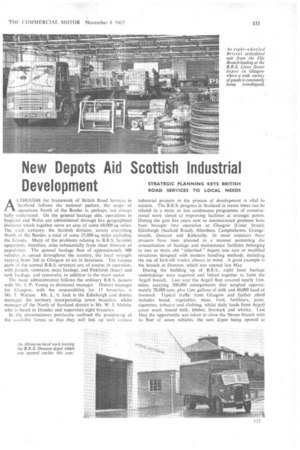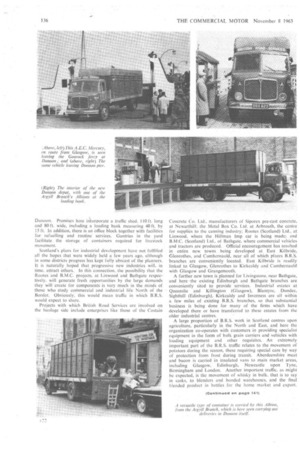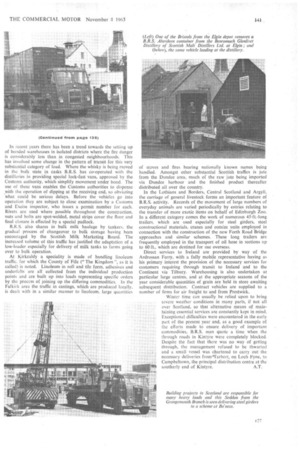New Depots Aid Scottish Industrial Development
Page 137

Page 138

Page 143

If you've noticed an error in this article please click here to report it so we can fix it.
ALTHOUGH the framework of British Road .Services in Scotland follows the national pattern, the scope of operations North of the Border is, perhaps, not always fully understood. On the general haulage side, operations in England and Wales are administered through five geographical divisions which together serve an area of some 60,000 sq. miles. The sixth territory, the Scottish division, covers everything North of the Border, a total of some 25,000 sq. miles excluding the Islands. Many of the problems relating to B.R.S. Scottish operations, therefore, arise substantially from sheer thinness of population. The general haulage fleet of approximately 900 vehicles is spread throughout the country, the local strength varying from 260 in Glasgow to six in Inverness. The various parts of the normal B.R.S. structure are, of course, in operation, with parcels, contracts, meat haulage, and Pickfords (heavy and tank haulage, and removals), in addition to the main sector.
The basic administration follows the ordinary B.R.S. pattern with Mr. J. P. Young as divisional manager. District manager for Glasgow, with the responsibility for 17 branches, is Mr. T. Watson. Mr. L. S. Jack is the Edinburgh and district manager, his territory incorporating seven branches, whilst manager of the North of Scotland district is Mr. W. J. Melvin, who is based in Dundee and supervises eight branches.
In the circumstances previously outlined the positioning of the available forces so that they will link up with various
industrial projects in the process of development is vital to success. The B.R.S. progress in Scotland in recent times can be related to a more or less continuous programme of constructional work aimed at improving facilities at strategic points. During the past five years new or reconstructed premises have been brought into operation at Glasgow (Lister Street), Edinburgh (Seatield Road), Aberdeen, Campbeltown, Grangemouth, Dunoon and Kirkcaldy. In most instances these projects have been planned in a manner permitting the concentration of haulage and maintenance facilities belonging to two or more old "inherited" depots into new or modified structures designed with modern handling methods, including the use of fork-lift trucks, always in mind. A good example is the branch at Dunoon, which was opened last May.
During the building up of B.R.S., eight local haulage undertakings were acquired and linked together to form the Argyll branch. Last year the Argyll fleet covered nearly 11m. miles, carrying 500,000 consignments that weighed approximately 70,000 tons. plus 11m. gallons of milk and 40,000 head of livestock. Typical traffic from Glasgow and farther afield includes bread, vegetables, meat, fruit, fertilizers, paint, cigarettes, tobacco and clothing, whilst daily loads from Argyll cover wool, tinned milk, timber, livestock and whisky. Last May the Opportunity was taken to close the Strone branch with its fleet of seven vehicles, the new depot being opened at Dunoon. Premises here iAorporate a traffic shed. I l0 ft. long and 80 ft. wide, including a loading bank measuring 40ft. by 15 ft. In addition, there is an Office block together with facilities for refuelling and routine services. Gantries in the yard facilitate the storage. of containers required for livestock movement. .
Scotland's plans for industrial development have not fulfilled all the hopes that were widely held a few years ago, although in some districts progress has kept fully abreast of the planners. It is naturally hoped that progressive new industries will, in time, attract others. In this connection, the possibility that the Rootes and B.M.C. projects, at Linwood and Batheate respectively, will generate fresh opportunities by the large demands they will create for components is very much in the minds of those who study commercial and industrial life North of the Border. Obviously, this would mean traffic in which B.R.S. would expect to share.
Projects with which British Road Services are involved on the haulage side include enterprises like those of the Costain Concrete Co. Ltd., manufacturers of Siporex pre-cast concrete, at Newarthill: the Metal Box Co. Ltd. at Arbroath, the centre for supplies to the canning industry; Rootes (Scotland) Ltd., at Linwood, where the Hillman Imp car is being made; and B.M:C. (Scotland) Ltd.. of Bathgate, where commercial vehicles and tractors are produced. Official encouragement has resulted in entire new, towns being developed at East Kilbride, Glenrothes, and Cumbernauld, near all of which places B.R.S. branches are Conveniently located. East Kilbride is readily linked to Glasgow, Glenrothes to Kirkcaldy and Cumbernauld with Glasgow and Grangemouth.
A further new town is planned for Livingstone, near Bathgate, and here-the existing Edinburgh and Bathgatc branches are conveniently sited to provide services. Industrial estates at Queenslie and Killington (Glasgow), Blantyre, Dundee, Sighthill (Edinburgh), Kirkcaldy and Inverness are all within a, few miles of existing B.R.S. branches, so that substantial business is being done for many of the firms which have developed there or have transferred to these estates from the older industrial centres.
A large proportion of B.R.S. work in Scotland centres upon agriculture, particularly in the North and East, and here the organization co-operates with customers in providing specialist equipment in the form of bulk grain carriers and vehicles with loading equipment and other requisites. An extremely important part of the B.R.S. traffic relates to the movement of potatoes during the. season, these requiring special care by way of protection from frost during transit. Aberdeenshire meat and bacon is carried in insulated vans to main market areas, including Glasgow, Edinburgh, Newcastle upon Tyne, Birmingham and London. Another important traffic, as might be expected, is the movement of whisky in bulk, that is to say in casks, to blenders and bonded warehouses, and the final blended product in bottles for the home market and export. In recent years there has been a trend towards the setting up of bonded warehouses in isolated districts where the fire danger is considerably less than in congested neighbourhoods. This has involved some change in the pattern of transit for this very substantial category of load. Where the whisky is being moved in the bulk state in casks B.R.S. has co-operated with the distilleries in providing special lock-fast vans, approved by the Customs authority, which simplify movement under bond. The use of these vans enables the Customs authorities to dispense with the operation of dipping at the receiving end, so obviating what could be serious delays. Before the vehicles go into operation they are subject to close examination by a Customs and Excise inspector, who issues a permit number for each. Rivets are used where possible throughout the construction. nuts and bolts are spot-welded, metal strips cover the floor and final closure is effected by a special padlock.
B.R.S. also shares in bulk milk haulage by tankers, the gradual process of changeover to bulk storage having been encouraged by the Scottish Milk Marketing Board. The increased volume of this traffic has justified the adaptation of a low-loader especially for delivery of milk tanks to farms going over to bulk operation.
At Kirkcaldy a speciality is made of handling linoleum traffic, for which the County of Fife (" The Kingdom ", as it is called) is noted. Linoleum in roll and tile form, adhesives and underfelts are all collected from the individual production points and are built up into loads representing specific orders by the process of joining up the differing commodities. In the Falkirk area the traffic in castings, which are produced locally. is dealt with in a similar manner to linoleum, large. quantities
of stoves and fires bearing nationally known names being handled. Amongst other substantial Scottish traffics is jute from the Dundee area, much of the raw jute being imported via Dundee harbour and the finished product thereafter distributed all over the country.
In the Lothians and Borders, Central Scotland and Argyll, the carriage of general livestock forms an important feature of B.R.S. activity. Records of the movement of large numbers of everyday animals are varied periodically by entries relating to the transfer of more exotic items on behalf of Edinburgh Zoo. In a different category comes the work of numerous 45-ft.-long trailers, which are used especially for steel girders, steel constructional' materials, cranes and outsize units employed in connection with the construction of the new Forth Road Bridge approaches and similar schemes. These long trailers are frequently employed in the transport of oil hose in sections up to 60 ft., which are destined for use overseas.
Direct services to Ireland are provided by way of the Ardrossan Ferry, with a fully mobile representative having as his primary interest the provision of the necessary services for customers requiring through transit to Ireland and to the Continent via Tilbury. Warehousing is also undertaken at particular large centres, and at the appropriate seasons of the year considerable quantities of grain are held in store awaiting subsequent distribution. Contract vehicles are supplied to a number of firms for air freight to and from Prestwick.
Winter time can usually be relied upon to bring severe weather conditions in many parts, if not all over Scotland, so that alternative means of maintaining essential services are constantly kept in mind. Exceptional difficulties were encountered in the early part of the present year and, as a good example of the efforts made to ensure delivery of important commodities, B.R.S. men quote a time when the through •roads in Kintyre were completely blocked. Despite the fact that there was no way of getting through, the management refused to be thwarted and a small vessel was chartered to carry out the necessary deliveries from41Farbert, on Loch Fyne, to Campbeltown, the principal distribution centre at the
southerly end of Kintyre. A.T.














































































































































































































































